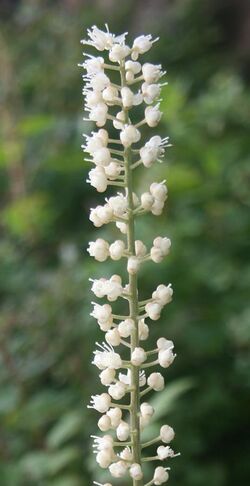Biology:Actaea simplex
| Actaea simplex | |
|---|---|

| |
| Aizu area, Fukushima pref., Japan | |
| Scientific classification Error creating thumbnail: Unable to save thumbnail to destination
| |
| Kingdom: | Plantae |
| Clade: | Tracheophytes |
| Clade: | Angiosperms |
| Clade: | Eudicots |
| Order: | Ranunculales |
| Family: | Ranunculaceae |
| Genus: | Actaea |
| Species: | A. simplex
|
| Binomial name | |
| Actaea simplex Wormsk. ex. Prantl[1]
| |
| Synonyms[2] | |
| |
Actaea simplex, the baneberry or bugbane, is a flowering plant in the buttercup family Ranunculaceae. A clump-forming rhizomatous herbaceous perennial, its native range includes the Kamchatka, Sakhalin and Siberian regions of Russia , western China , Manchuria, Mongolia, Korea and Japan .[3] Plants may be harmful if eaten, and the sap may irritate the skin.[4] The genus name Actaea is the Latin name adopted by Linnaeus from Pliny. The specific epithet simplex means simple or unbranched.[5] The common name "bugbane" refers to the fact that the leaves' scent repels insects.[6]
Description
Growing to 1.2 metres (3.9 ft) tall by 0.6 metres (2.0 ft) wide,[4] it has trifoliate and pinnate basal leaves. In summer it produces erect or arching stems with short terminal racemes of fragrant white blooms. It grows best in medium-moisture soils and part shade to full shade. In the United States , it is suitable for hardiness zones 4 to 8.[5] It is important not to let the plants dry out in hot, sunny situations.[6]
Cultivation
In cultivation in the UK, plants are still referenced and sold under their former name Cimicifuga simplex.[7]
They are popular garden plants, valued for summer colour. The Atropurpurea Group have deep purple or black stems with pink-tinged flowers. The following have gained the Royal Horticultural Society’s Award of Garden Merit:-
References
| Wikimedia Commons has media related to Actaea simplex. |
- ↑ "Actaea simplex". The Plant List. http://www.theplantlist.org/tpl1.1/record/kew-2620576.
- ↑ The Plant List, Actaea simplex (DC.) Wormsk. ex Prantl
- ↑ Brickell, Christopher, ed (2008). The Royal Horticultural Society A-Z Encyclopedia of Garden Plants. United Kingdom: Dorling Kindersley. p. 276. ISBN 9781405332965.
- ↑ 4.0 4.1 "Actaea simplex 'Atropurpurea Group' - bugbane ( syn. Cimicifuga )" (in en). https://www.crocus.co.uk/plants/_/actaea-simplex-atropurpurea-group/classid.1372/.
- ↑ 5.0 5.1 "Actaea simplex - Plant Finder". https://www.missouribotanicalgarden.org/PlantFinder/PlantFinderDetails.aspx?taxonid=291420&isprofile=1&basic=actaea%20simplex.
- ↑ 6.0 6.1 "Actaea simplex". http://www.thegardenersalmanac.co.uk/Content/A/Actaea/Actaea.htm.
- ↑ Bourne, Val (24 August 2002). "The Telegraph: How to grow: Bugbane". telegraph.co.uk. https://www.telegraph.co.uk/gardening/howtogrow/3303895/How-to-grow-Bugbane.html.
- ↑ "Actaea simplex (Atropurpurea Group) 'Brunette'". Royal Horticultural Society. https://www.rhs.org.uk/Plants/165617/i-Actaea-simplex-i-(Atropurpurea-Group)-Brunette/Details.
- ↑ "Actaea simplex (Atropurpurea Group) 'Hillside Black Beauty'". Royal Horticultural Society. https://www.rhs.org.uk/Plants/166899/i-Actaea-simplex-i-(Atropurpurea-Group)-Hillside-Black-Beauty/Details.
- ↑ "Actaea simplex (Atropurpurea Group) 'James Compton'". Royal Horticultural Society. https://www.rhs.org.uk/Plants/165625/i-Actaea-simplex-i-(Atropurpurea-Group)-James-Compton/Details.
Wikidata ☰ Q892703 entry
 |


